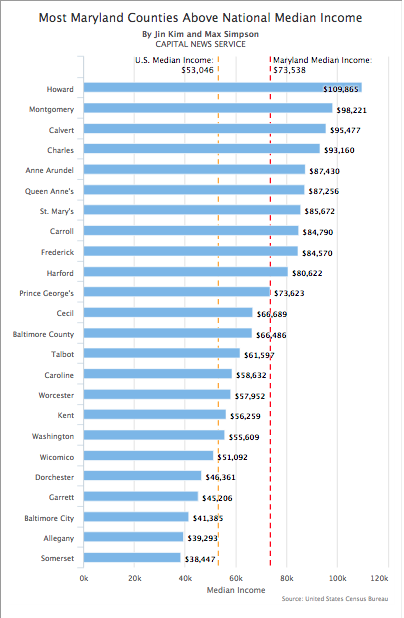WASHINGTON–Maryland boasts a “strong economic foundation” but it needs to address a “triple bottom line”–economic, social and environmental challenges–to enjoy long-term economic prosperity, according to a report released Thursday by The University of Maryland’s National Center for Smart Growth.
“Maryland’s long-term economic future depends on fundamentals like a skilled and well-educated workforce, a sound and efficient transportation system, adequate land and urban infrastructure and a high quality of life,” said Dr. Gerrit Knaap, Director of the National Center for Smart Growth and the lead investigator on the report.
The report, which is based on a three-year study funded in part by the Surdna and Abell Foundations, reviews trends in the economy and uses its predictions of Maryland’s “foreseeable future” as a basis for its recommendations.
While the state is emerging from the Great Recession “rather slowly,” the state’s cumulative growth in GDP is 20 percent higher than the national average.
“Maryland has made sound investments in transportation, education, workforce development and environmental protection,” said Knaap. “It also has the advantage of being in a real good location–right next to D.C.”
Despite Maryland leading the nation in many economic indicators, such as having a stable economic base and a resistance to economic downturns, the state faces many 21st century challenges that need to be addressed. These include aging infrastructure and economic disparities.
Wages of top earners now exceed pre-recession levels, but real wages for most Maryland households have continued to decline. High poverty rates continue to plague the state’s most vulnerable populations, including the unemployed, disabled, Hispanic and female-headed households.
The report stresses that low-income residents need to have access to opportunity. Recommendations include meeting the needs of Maryland’s diverse population by expanding opportunities for education and workforce training, which would allow for more affordable housing near job centers.
Maryland also faces a change in leadership this year. After Democratic Gov. Martin O’Malley led the state for eight years, Republican Larry Hogan became governor in January after running on a platform of tax reduction, fiscal restraint and economic development.
When asked if Hogan’s economic policies lined up with the report’s recommendations, Knaap responded, “It’s a little early to tell, but his focus on economic development is welcome as long as his policies keep an eye on long-term as well as short-term payoffs.”
If the state does not adequately address the issues outlined in the report, Knaap warns that the quality of life in Maryland could take a turn for the worse.
“Without keeping an eye on the triple bottom line, Maryland will become a less attractive place to live and do business,” said Knaap. “In economic development as well as policy domains, balance is the key to success.”

